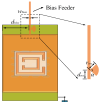MCML-BF: A Metal-Column Embedded Microstrip Line Transmission Structure with Bias Feeders for Beam-Scanning Leakage Antenna Design
- PMID: 38894261
- PMCID: PMC11174548
- DOI: 10.3390/s24113467
MCML-BF: A Metal-Column Embedded Microstrip Line Transmission Structure with Bias Feeders for Beam-Scanning Leakage Antenna Design
Abstract
This article proposes a novel fixed-frequency beam scanning leakage antenna based on a liquid crystal metamaterial (LCM) and adopting a metal column embedded microstrip line (MCML) transmission structure. Based on the microstrip line (ML) transmission structure, it was observed that by adding two rows of metal columns in the dielectric substrate, electromagnetic waves can be more effectively transmitted to reduce dissipation, and attenuation loss can be lowered to improve energy radiation efficiency. This antenna couples TEM mode electromagnetic waves into free space by periodically arranging 72 complementary split ring resonators (CSRRs). The LC layer is encapsulated in the transmission medium between the ML and the metal grounding plate. The simulation results show that the antenna can achieve a 106° continuous beam turning from reverse -52° to forward 54° at a frequency of 38 GHz with the holographic principle. In practical applications, beam scanning is achieved by applying a DC bias voltage to the LC layer to adjust the LC dielectric constant. We designed a sector-blocking bias feeder structure to minimize the impact of RF signals on the DC source and avoid the effect of DC bias on antenna radiation. Further comparative experiments revealed that the bias feeder can significantly diminish the influence between the two sources, thereby reducing the impact of bias voltage introduced by LC layer feeding on antenna performance. Compared with existing approaches, the antenna array simultaneously combines the advantages of high frequency band, high gain, wide beam scanning range, and low loss.
Keywords: beam scanning; bias feeder; holographic principle; liquid crystal; periodic leakage antenna.
Conflict of interest statement
The authors declare no conflict of interest.
Figures

















References
-
- Wei D., Zhang P. A Linearly and Circularly Polarization-Reconfigurable Leaky Wave Antenna Based on SSPPs-HSIW. Electronics. 2023;12:2602. doi: 10.3390/electronics12122602. - DOI
LinkOut - more resources
Full Text Sources
Miscellaneous

